INCENTIVE TO OVERPRODUCE INVENTORY
The absorption of fixed overhead costs as part of the cost of inventory on the balance sheet presents ethical challenges because it provides the opportunity to manipulate reported income. This classic case is based on an actual company’s experience.*
Brandolino Company uses an actual-cost system to apply all production costs to units produced. The plant has a maximum production capacity of 40 million units but during year 1 it produced and sold only 10 million units. There were no beginning or ending inventories. The company’s absorption-costing income statement for year 1 follows:
BRANDOLINO COMPANY
Income Statement
For Year 1
Sales (10,000,000 units at $6)
$ 60,000,000
Cost of goods sold:
Direct costs (material and labor) (10,000,000 at $2)
$20,000,000
Manufacturing overhead
48,000,000
68,000,000
Gross margin
$ (8,000,000)
Less: Selling and administrative expenses
10,000,000
Operating income (loss)
$(18,000,000)
The board of directors is upset about the $18 million loss. A consultant approached the board with the following Page 345offer: “I agree to become president for no fixed salary. But I insist on a year-end bonus of 10 percent of operating income (before considering the bonus).” The board of directors agreed to these terms and hired the consultant as Brandolino’s new president. The new president promptly stepped up production to an annual rate of 30 million units. Sales for year 2 remained at 10 million units. Here is the resulting absorption-costing income statement for year 2:
BRANDOLINO COMPANY
Income Statement
For Year 2
Sales (10,000,000 units at $6)
$60,000,000
Cost of goods sold:
Costs of goods manufactured:
Direct costs (material and labor) (30,000,000 at $2)
$60,000,000
Manufacturing overhead
48,000,000
Total cost of goods
manufactured
$108,000,000
Less: Ending inventory:
Direct costs (material and labor) (20,000,000 at $2)
$40,000,000
Manufacturing overhead (20/30 × $48,000,000)
32,000,000
Total ending inventory costs
$72,000,000
Cost of goods sold
36,000,000
Gross margin
$24,000,000
Less: Selling and administrative expenses
10,000,000
Operating income before bonus
$14,000,000
Bonus
1,400,000
Operating income after bonus
$12,600,000
The day after the year 2 statement was verified, the president took his check for $1,400,000 and resigned to take a job with another corporation. He remarked, “I enjoy challenges. Now that Brandolino Company is in the black, I’d prefer tackling another challenging situation.” (His contract with his new employer is similar to the one he had with Brandolino Company.)
What do you think is going on here?
How would you evaluate the company’s year 2 performance?
Using variable costing, what would operating income be for year 1? For year 2? (Assume that all selling and administrative costs are committed and unchanged.)
Compare those results with the absorption-costing statements.
INCENTIVE TO OVERPRODUCE INVENTORY
The absorption of fixed overhead costs as part of the cost of inventory on the balance sheet presents ethical challenges because it provides the opportunity to manipulate reported income. This classic case is based on an actual company’s experience.*
Brandolino Company uses an actual-cost system to apply all production costs to units produced. The plant has a maximum production capacity of 40 million units but during year 1 it produced and sold only 10 million units. There were no beginning or ending inventories. The company’s absorption-costing income statement for year 1 follows:
BRANDOLINO COMPANY
Income Statement
For Year 1
Sales (10,000,000 units at $6)
$ 60,000,000
Cost of goods sold:
Direct costs (material and labor) (10,000,000 at $2)
$20,000,000
Manufacturing overhead
48,000,000
68,000,000
Gross margin
$ (8,000,000)
Less: Selling and administrative expenses
10,000,000
Operating income (loss)
$(18,000,000)
The board of directors is upset about the $18 million loss. A consultant approached the board with the following Page 345offer: “I agree to become president for no fixed salary. But I insist on a year-end bonus of 10 percent of operating income (before considering the bonus).” The board of directors agreed to these terms and hired the consultant as Brandolino’s new president. The new president promptly stepped up production to an annual rate of 30 million units. Sales for year 2 remained at 10 million units. Here is the resulting absorption-costing income statement for year 2:
BRANDOLINO COMPANY
Income Statement
For Year 2
Sales (10,000,000 units at $6)
$60,000,000
Cost of goods sold:
Costs of goods manufactured:
Direct costs (material and labor) (30,000,000 at $2)
$60,000,000
Manufacturing overhead
48,000,000
Total cost of goods
manufactured
$108,000,000
Less: Ending inventory:
Direct costs (material and labor) (20,000,000 at $2)
$40,000,000
Manufacturing overhead (20/30 × $48,000,000)
32,000,000
Total ending inventory costs
$72,000,000
Cost of goods sold
36,000,000
Gross margin
$24,000,000
Less: Selling and administrative expenses
10,000,000
Operating income before bonus
$14,000,000
Bonus
1,400,000
Operating income after bonus
$12,600,000
The day after the year 2 statement was verified, the president took his check for $1,400,000 and resigned to take a job with another corporation. He remarked, “I enjoy challenges. Now that Brandolino Company is in the black, I’d prefer tackling another challenging situation.” (His contract with his new employer is similar to the one he had with Brandolino Company.)
What do you think is going on here?
How would you evaluate the company’s year 2 performance?
Using variable costing, what would operating income be for year 1? For year 2? (Assume that all selling and administrative costs are committed and unchanged.)
Compare those results with the absorption-costing statements.
INCENTIVE TO OVERPRODUCE INVENTORY
The absorption of fixed overhead costs as part of the cost of inventory on the balance sheet presents ethical challenges because it provides the opportunity to manipulate reported income. This classic case is based on an actual company’s experience.*
Brandolino Company uses an actual-cost system to apply all production costs to units produced. The plant has a maximum production capacity of 40 million units but during year 1 it produced and sold only 10 million units. There were no beginning or ending inventories. The company’s absorption-costing income statement for year 1 follows:
BRANDOLINO COMPANY
Income Statement
For Year 1
Sales (10,000,000 units at $6)
$ 60,000,000
Cost of goods sold:
Direct costs (material and labor) (10,000,000 at $2)
$20,000,000
Manufacturing overhead
48,000,000
68,000,000
Gross margin
$ (8,000,000)
Less: Selling and administrative expenses
10,000,000
Operating income (loss)
$(18,000,000)
The board of directors is upset about the $18 million loss. A consultant approached the board with the following Page 345offer: “I agree to become president for no fixed salary. But I insist on a year-end bonus of 10 percent of operating income (before considering the bonus).” The board of directors agreed to these terms and hired the consultant as Brandolino’s new president. The new president promptly stepped up production to an annual rate of 30 million units. Sales for year 2 remained at 10 million units. Here is the resulting absorption-costing income statement for year 2:
BRANDOLINO COMPANY
Income Statement
For Year 2
Sales (10,000,000 units at $6)
$60,000,000
Cost of goods sold:
Costs of goods manufactured:
Direct costs (material and labor) (30,000,000 at $2)
$60,000,000
Manufacturing overhead
48,000,000
Total cost of goods
manufactured
$108,000,000
Less: Ending inventory:
Direct costs (material and labor) (20,000,000 at $2)
$40,000,000
Manufacturing overhead (20/30 × $48,000,000)
32,000,000
Total ending inventory costs
$72,000,000
Cost of goods sold
36,000,000
Gross margin
$24,000,000
Less: Selling and administrative expenses
10,000,000
Operating income before bonus
$14,000,000
Bonus
1,400,000
Operating income after bonus
$12,600,000
The day after the year 2 statement was verified, the president took his check for $1,400,000 and resigned to take a job with another corporation. He remarked, “I enjoy challenges. Now that Brandolino Company is in the black, I’d prefer tackling another challenging situation.” (His contract with his new employer is similar to the one he had with Brandolino Company.)
What do you think is going on here?
How would you evaluate the company’s year 2 performance?
Using variable costing, what would operating income be for year 1? For year 2? (Assume that all selling and administrative costs are committed and unchanged.)
Compare those results with the absorption-costing statements.
INCENTIVE TO OVERPRODUCE INVENTORY
The absorption of fixed overhead costs as part of the cost of inventory on the balance sheet presents ethical challenges because it provides the opportunity to manipulate reported income. This classic case is based on an actual company’s experience.*
Brandolino Company uses an actual-cost system to apply all production costs to units produced. The plant has a maximum production capacity of 40 million units but during year 1 it produced and sold only 10 million units. There were no beginning or ending inventories. The company’s absorption-costing income statement for year 1 follows:
BRANDOLINO COMPANY
Income Statement
For Year 1
Sales (10,000,000 units at $6)
$ 60,000,000
Cost of goods sold:
Direct costs (material and labor) (10,000,000 at $2)
$20,000,000
Manufacturing overhead
48,000,000
68,000,000
Gross margin
$ (8,000,000)
Less: Selling and administrative expenses
10,000,000
Operating income (loss)
$(18,000,000)
The board of directors is upset about the $18 million loss. A consultant approached the board with the following Page 345offer: “I agree to become president for no fixed salary. But I insist on a year-end bonus of 10 percent of operating income (before considering the bonus).” The board of directors agreed to these terms and hired the consultant as Brandolino’s new president. The new president promptly stepped up production to an annual rate of 30 million units. Sales for year 2 remained at 10 million units. Here is the resulting absorption-costing income statement for year 2:
BRANDOLINO COMPANY
Income Statement
For Year 2
Sales (10,000,000 units at $6)
$60,000,000
Cost of goods sold:
Costs of goods manufactured:
Direct costs (material and labor) (30,000,000 at $2)
$60,000,000
Manufacturing overhead
48,000,000
Total cost of goods
manufactured
$108,000,000
Less: Ending inventory:
Direct costs (material and labor) (20,000,000 at $2)
$40,000,000
Manufacturing overhead (20/30 × $48,000,000)
32,000,000
Total ending inventory costs
$72,000,000
Cost of goods sold
36,000,000
Gross margin
$24,000,000
Less: Selling and administrative expenses
10,000,000
Operating income before bonus
$14,000,000
Bonus
1,400,000
Operating income after bonus
$12,600,000
The day after the year 2 statement was verified, the president took his check for $1,400,000 and resigned to take a job with another corporation. He remarked, “I enjoy challenges. Now that Brandolino Company is in the black, I’d prefer tackling another challenging situation.” (His contract with his new employer is similar to the one he had with Brandolino Company.)
What do you think is going on here?
How would you evaluate the company’s year 2 performance?
Using variable costing, what would operating income be for year 1? For year 2? (Assume that all selling and administrative costs are committed and unchanged.)
Compare those results with the absorption-costing statements.
1. Here the Manufacturing Expenses plays a vital role as it remain unchanged while changed in production units. Hence, it is consider as fixed cost while evaluating performance of the company. Company’s Performance for 2 year is as under:
Particulars
Amount in $
Sales (10,000,000 X $6)
60,000,000
Less:
Raw Material and Labour Cost (30,000,000 X $2)
60,000,000
Manufacturing Expenses
48,000,000
Add/Less: Stock Adjustment
Add: Closing Stock of WIP [(20,000,000 X $2) + (48,000,000 X 20/40)]
64,000,000
Less: Opening Stock of WIP
--
Gross margin
16,000,000
Less: Selling and administrative expenses
10,000,000
Operating income
6,000,000
2. Operating Profit under operating Costing method:
Particulars
Year-1
Year-2
Sales
60,000,000
60,000,000
Less Variable Cost
Raw Material & labour
20,000,000
20,000,000
Operating Profit
40,000,000
40,000,000
3. Comparison of Absorption Costing and variable Costing
While comparing the operating profit calculated in point 2 with profit of Absorption costing method we can see that there is no increase in operating profit. In year 1 the company has absorbed al the Manufacturing expenses to the produced 10 million units against its installed capacity of 40 million units which leads the company in the operating loss for first year.
| Particulars | Amount in $ |
| Sales (10,000,000 X $6) | 60,000,000 |
| Less: | |
| Raw Material and Labour Cost (30,000,000 X $2) | 60,000,000 |
| Manufacturing Expenses | 48,000,000 |
| Add/Less: Stock Adjustment | |
| Add: Closing Stock of WIP [(20,000,000 X $2) + (48,000,000 X 20/40)] | 64,000,000 |
| Less: Opening Stock of WIP | -- |
| Gross margin | 16,000,000 |
| Less: Selling and administrative expenses | 10,000,000 |
| Operating income | 6,000,000 |
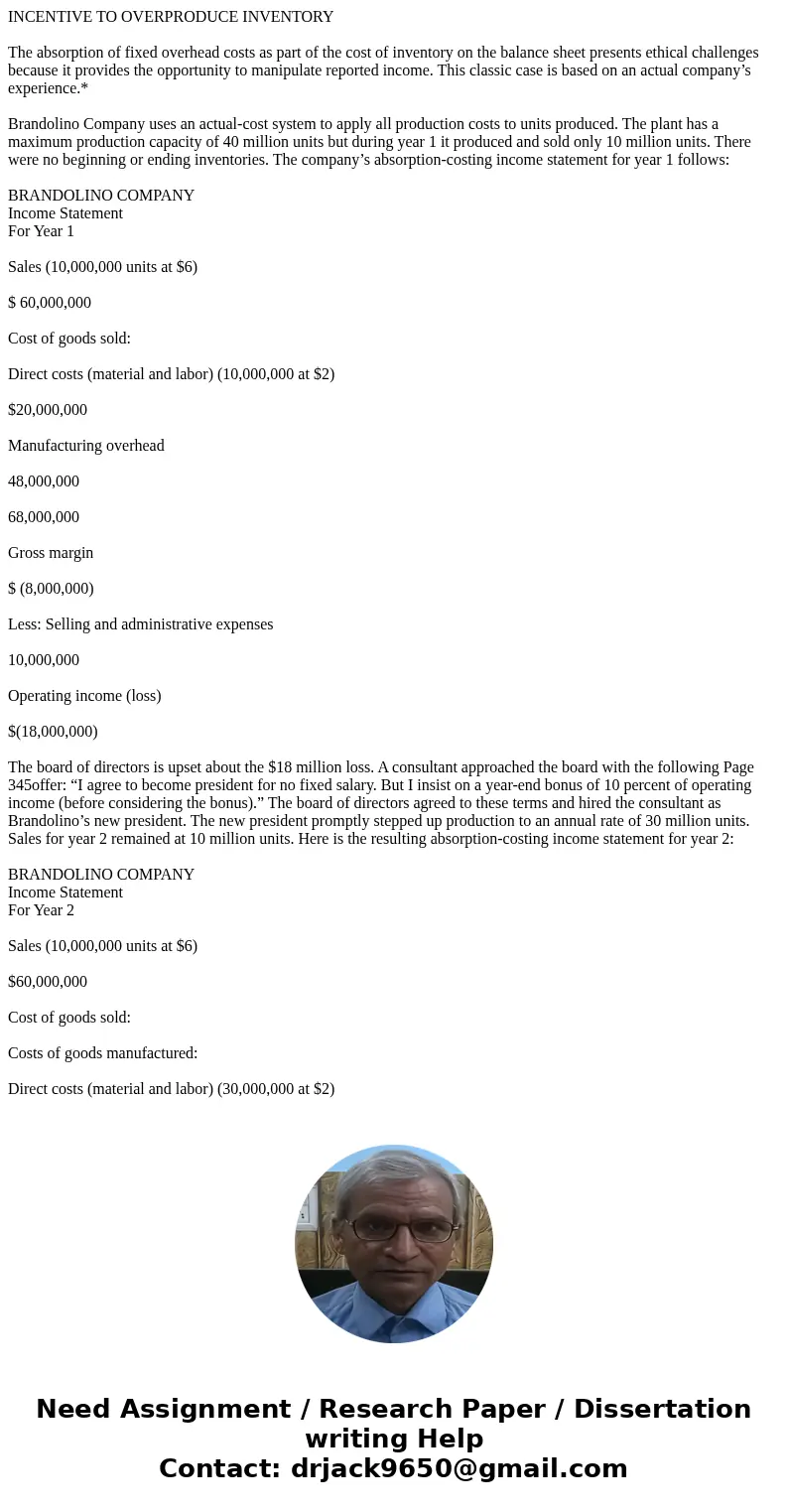
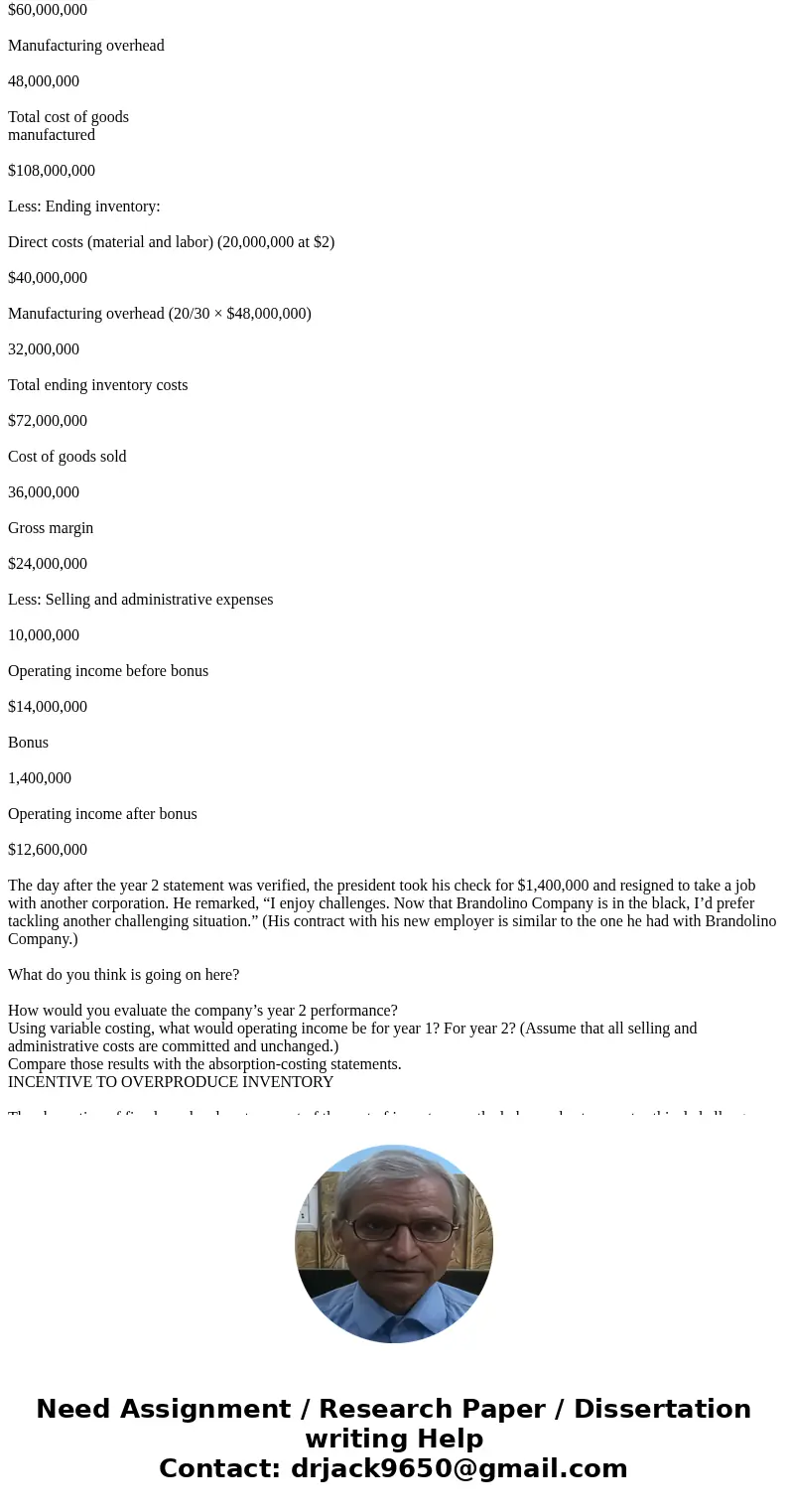
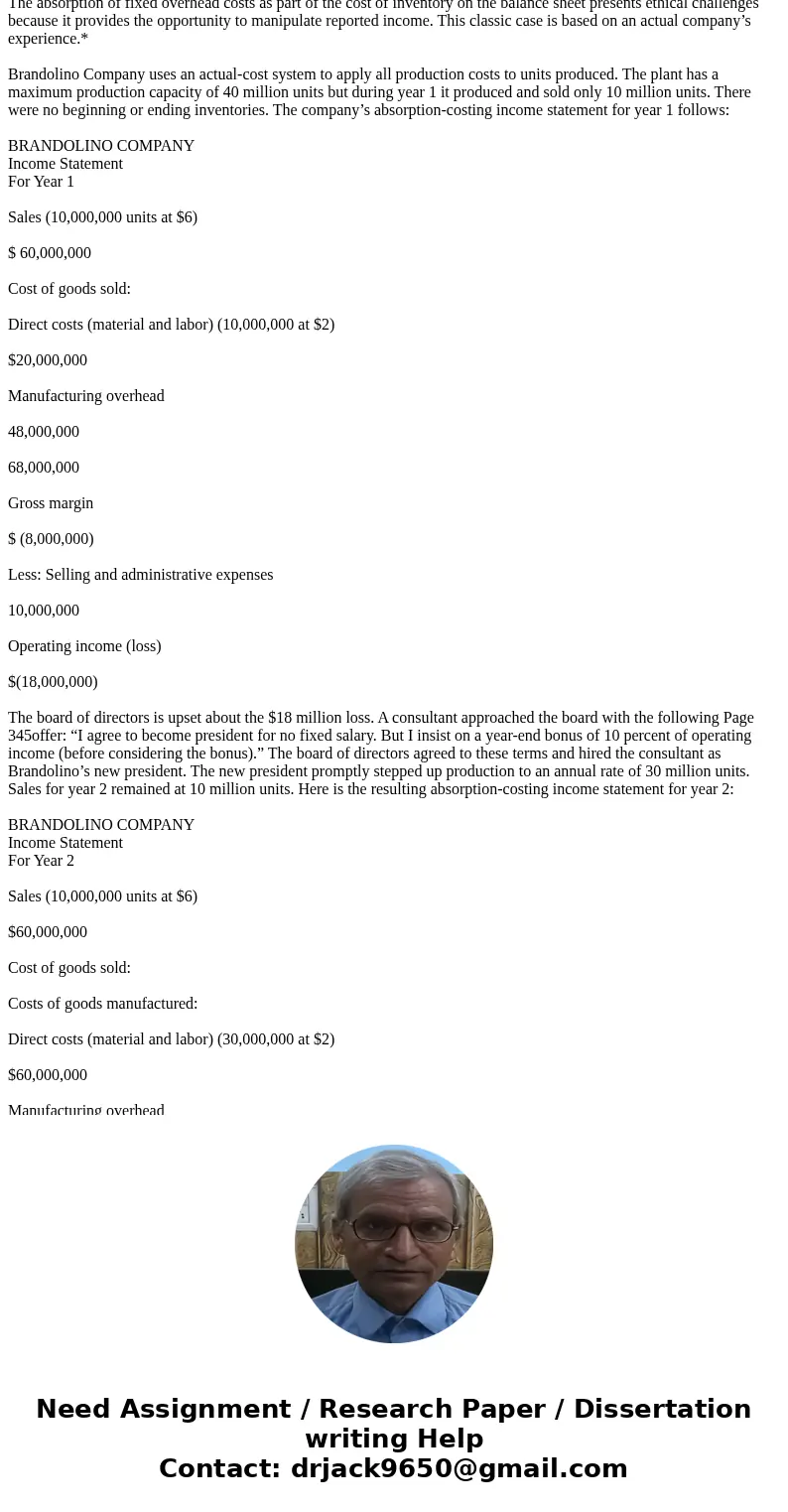
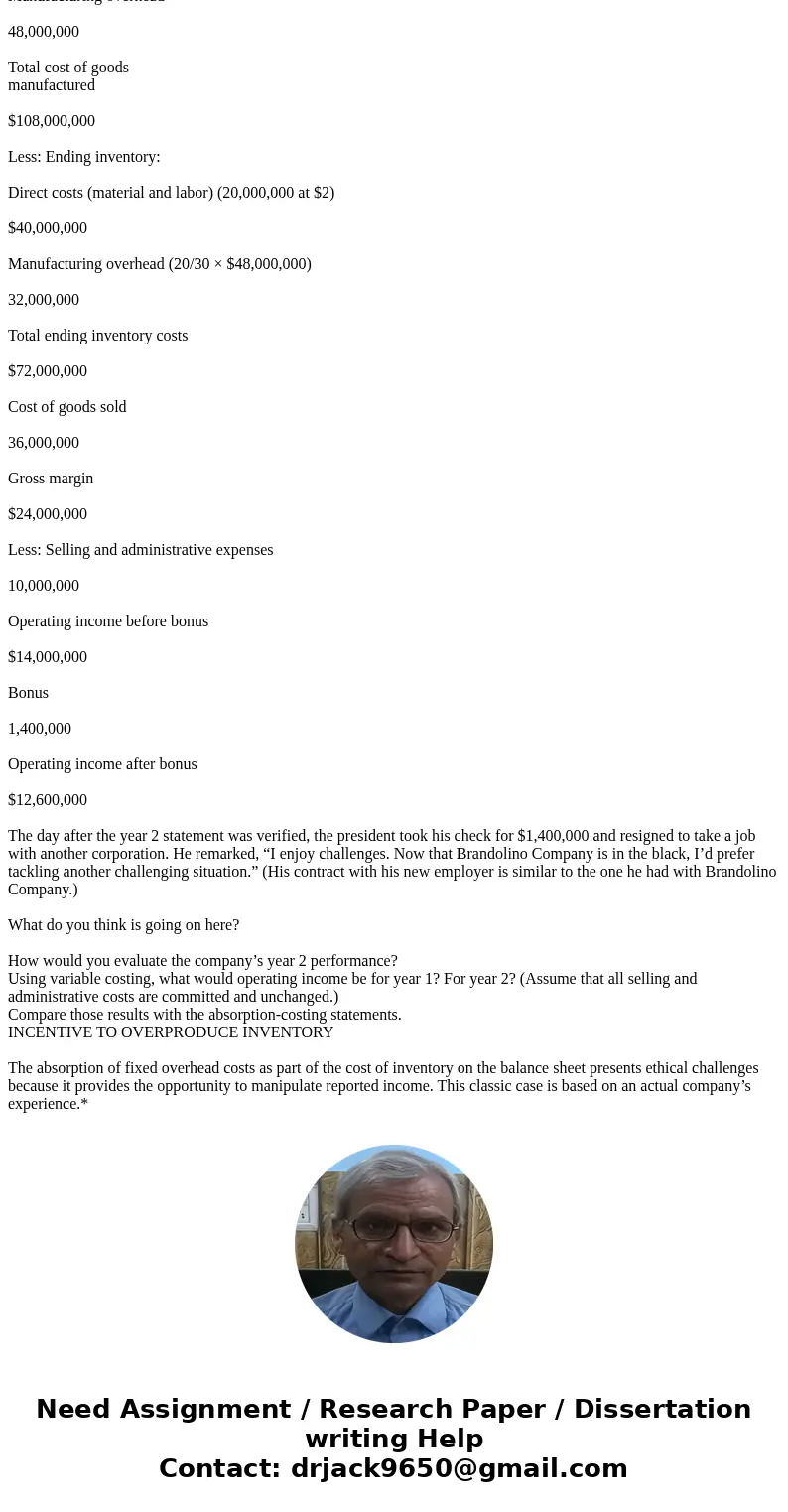
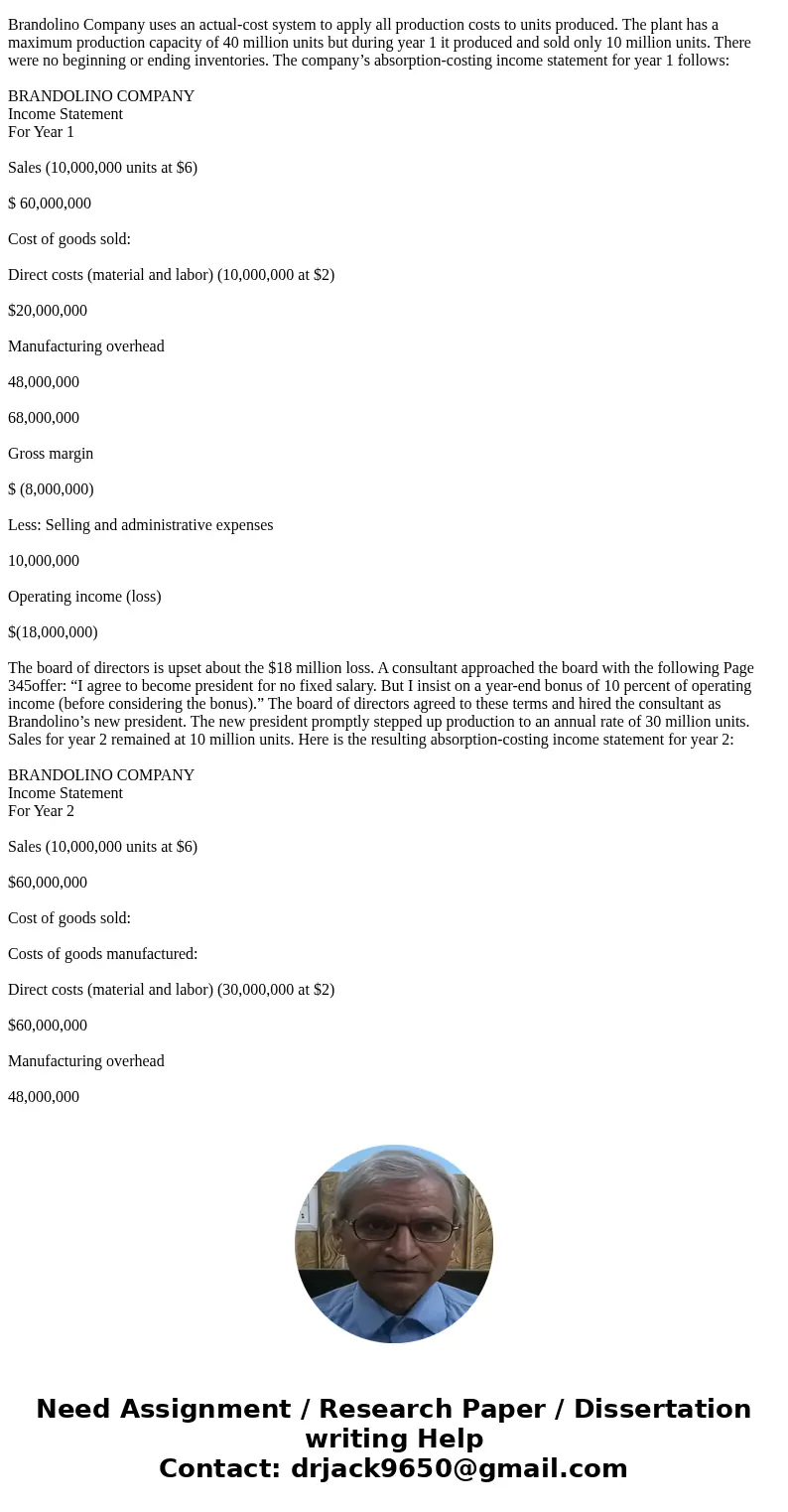
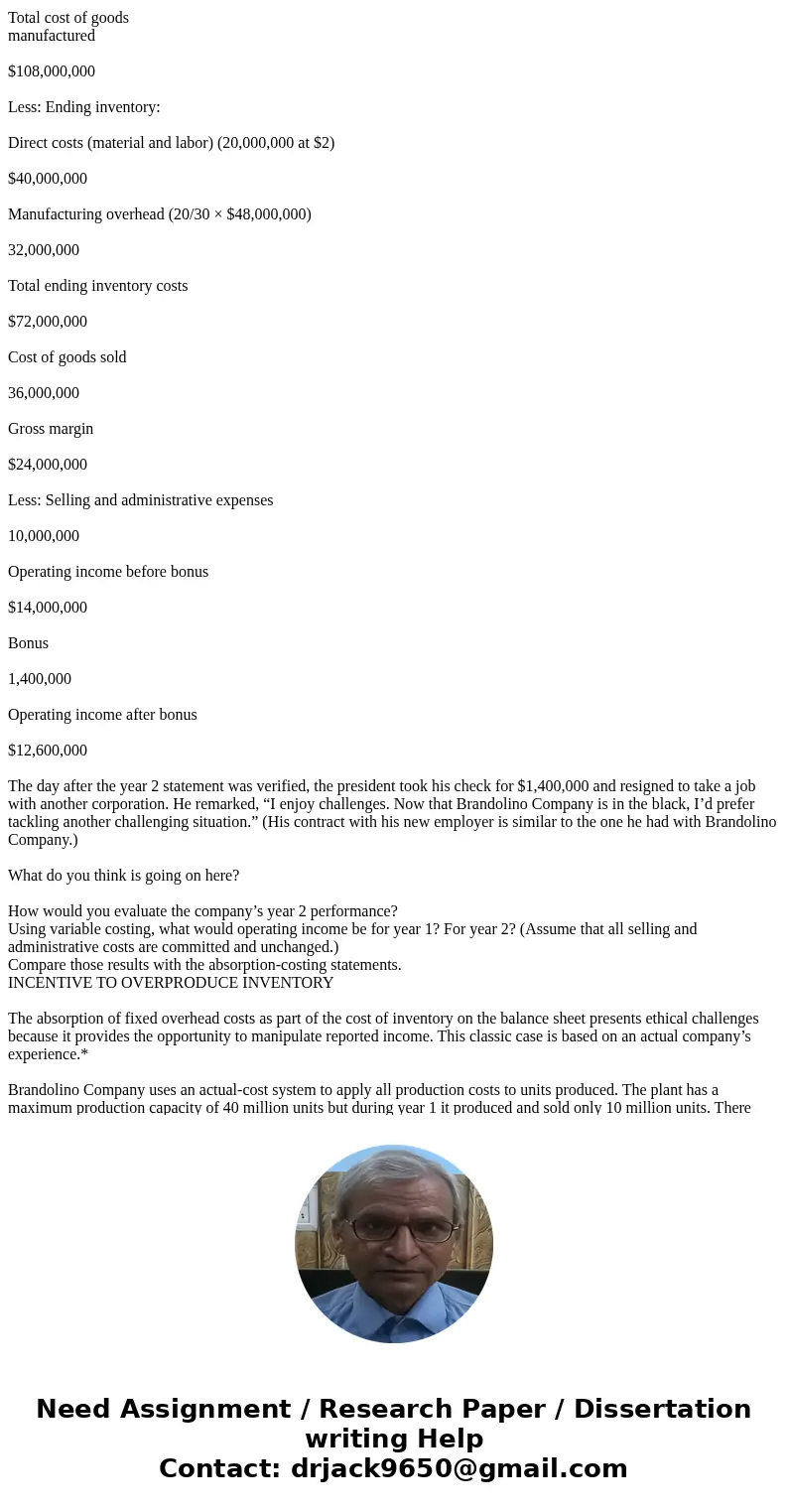
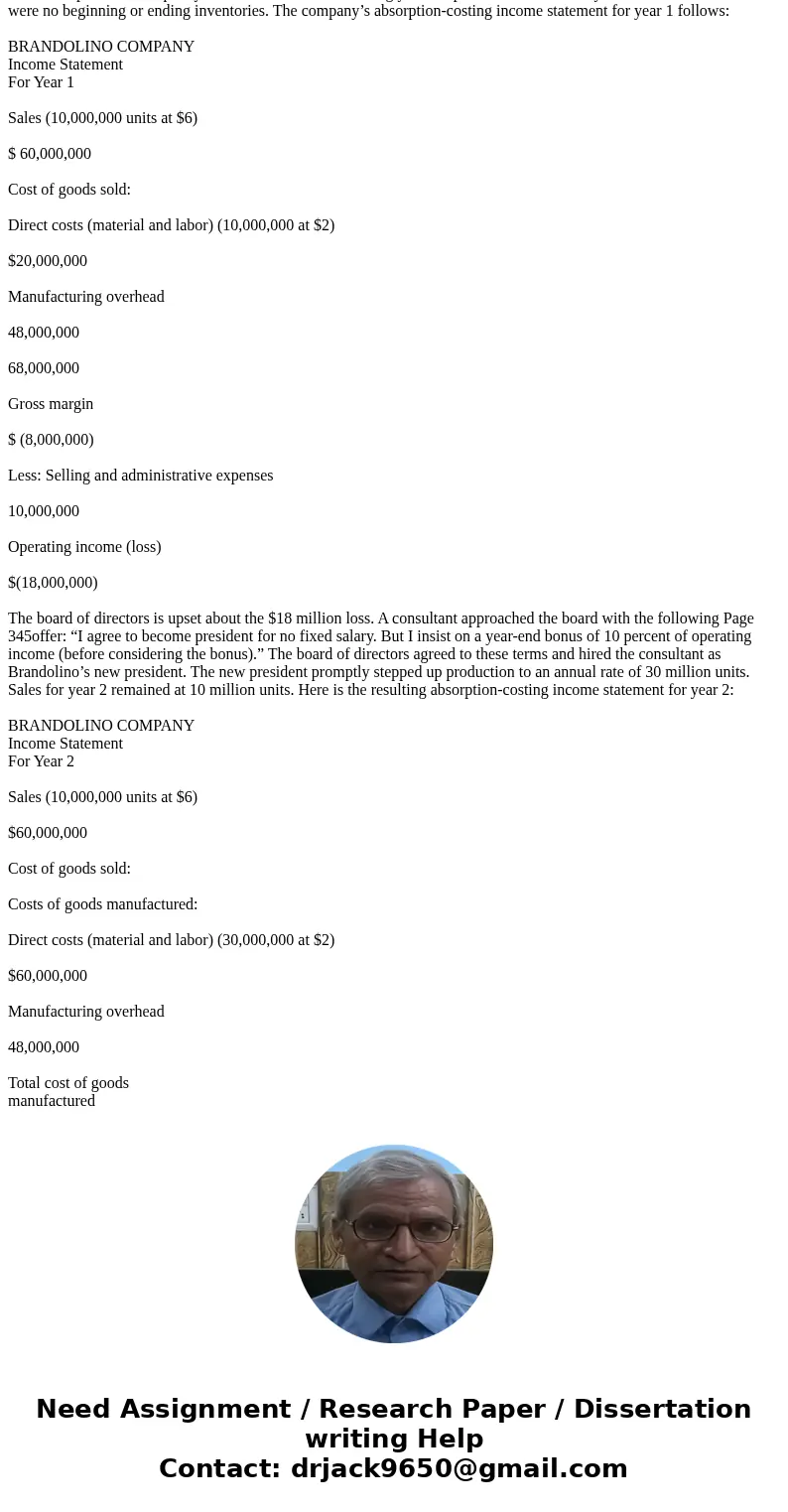
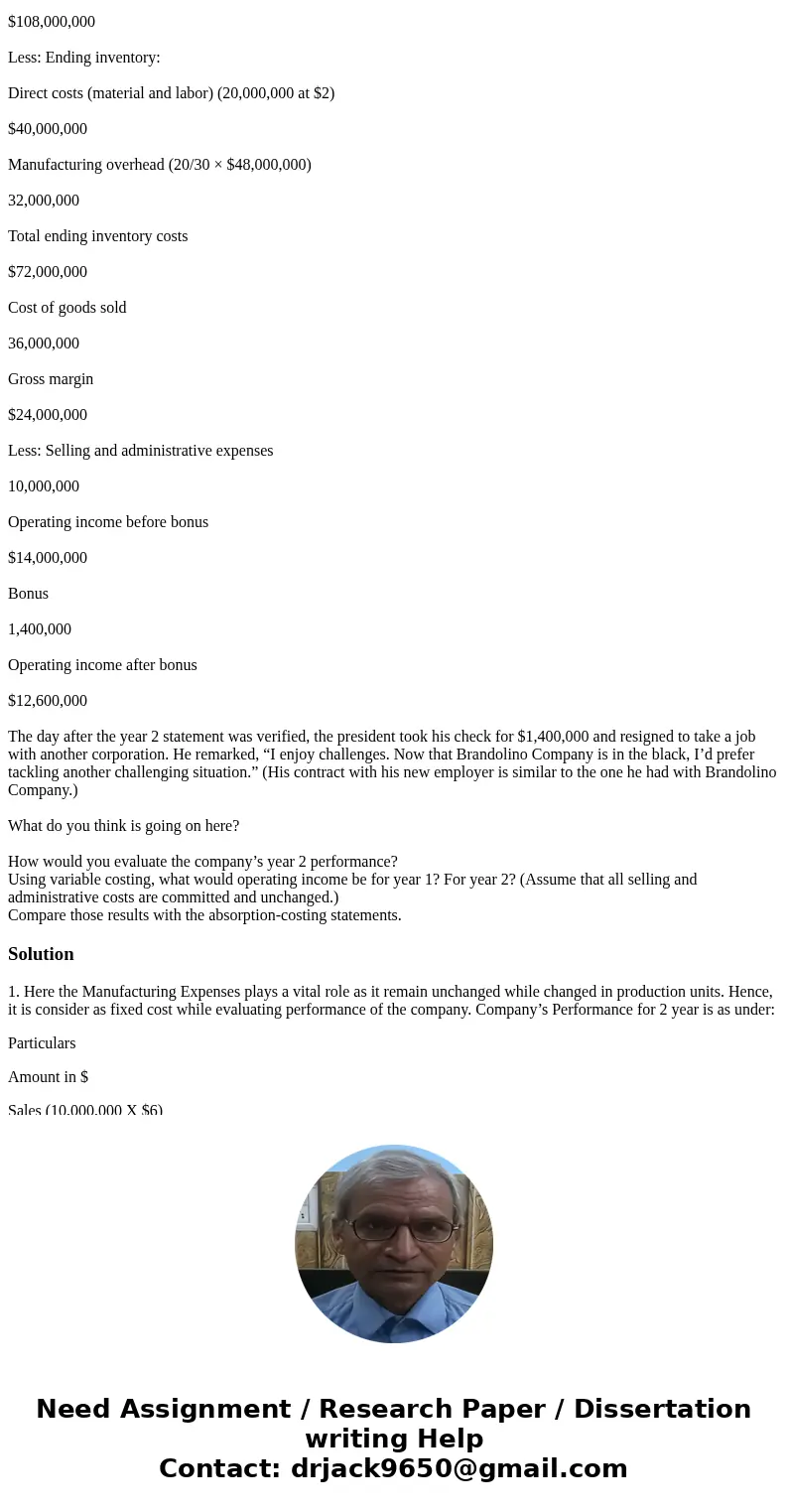
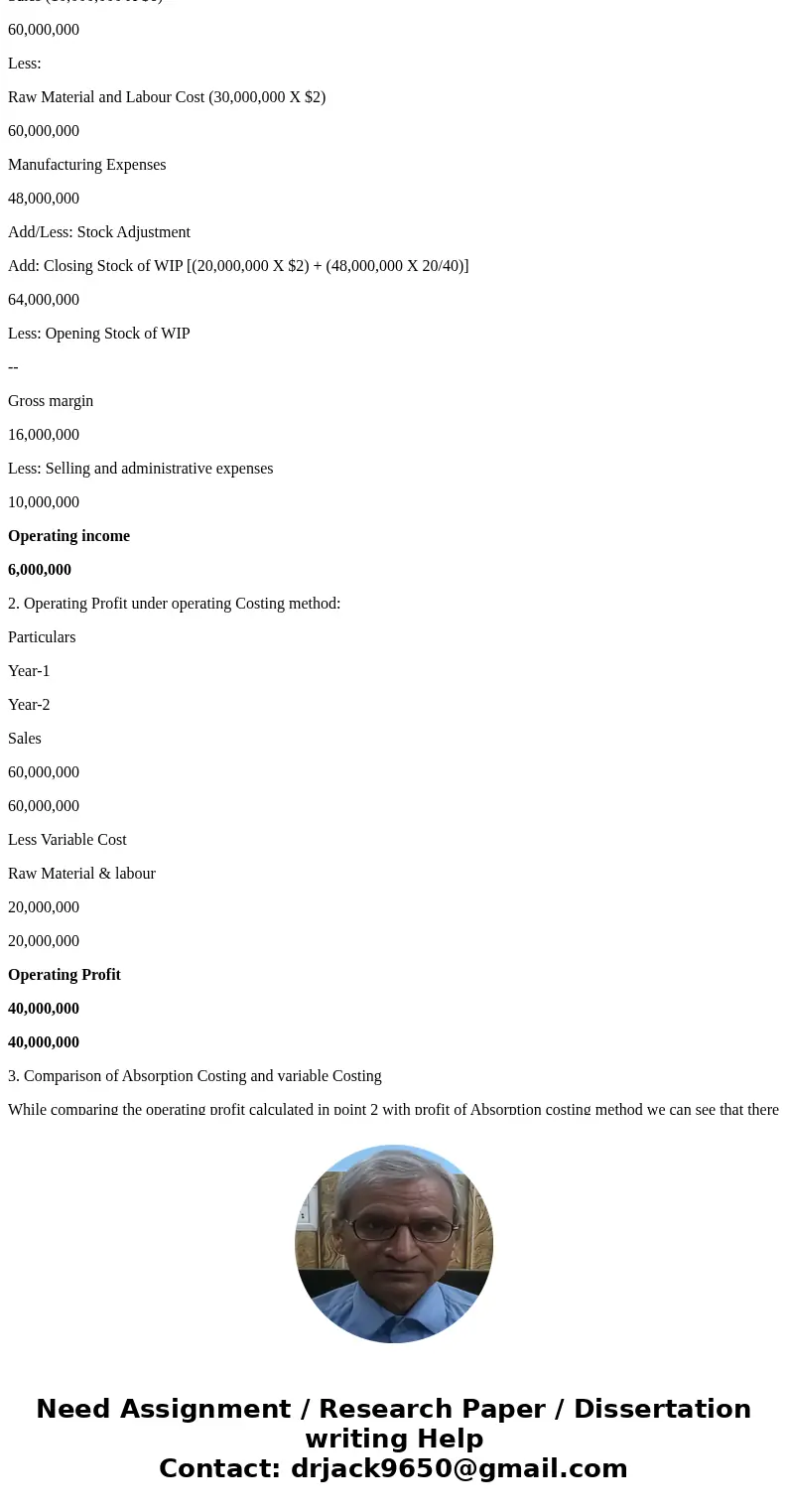
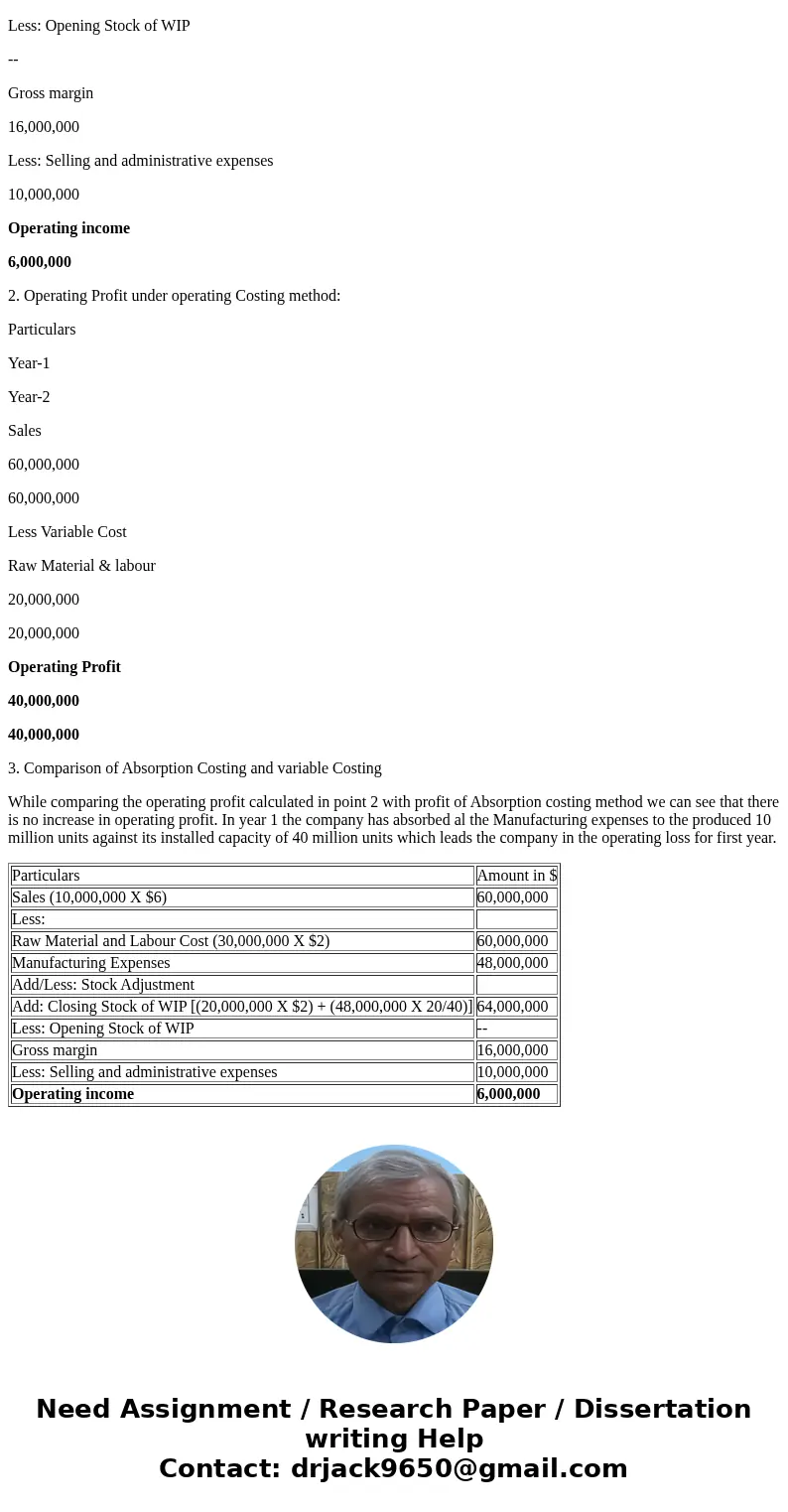
 Homework Sourse
Homework Sourse